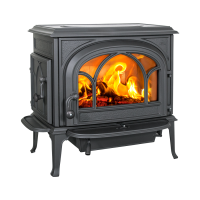6
139681_R06 F 500 Oslo 1/20
3.3 Prefabricated Chimneys
When installing the Jøtul F 500 to a prefabricated metal chimney
always follow the pipe manufacture’s instructions and be sure
to use the components that are required. This usually includes
some type of “smoke pipe adapter” that is secured to the bottom
section of the metal chimney and allows the chimney pipe to
be secured to it with three sheet metal screws. See figure 7.
4.0 Clearances to
Combustibles
4.1 Floor Protection
Floor protection under the stove must be composed of continuous
non-combustible materials for protection from sparks and
embers. Install the supplied bottom heatshield. Alcove
installations also require a minimum R-value of 1.6 for thermal
protection.
Individual sections of floor protection must be mortared together
to prevent sparks from falling through to combustible materials.
Any carpeting must be removed from under the floor protection.
In the U.S. and Canada
The Jøtul F 500 must be installed on a non-combustible surface
extending:
A minimum of 18” (457mm) in front of the stove and the left side
load door (measured from the legs).
And 8” (200mm) on the right side and back of the stove
(measured from side and back panels).
This will result in a minimum floor protection of
54.25”W X 50,5”D (1378mm x 1283mm). See figure 8.
In a rear vent installation the floor protection must also extend
under the stove pipe a minimum of 2” (50mm) beyond either
side of the pipe.
Alternate hearth protection
A hearth pad measuring 46”wide X 50,5” deep (1168mmx1283mm)
can be used only if the left side door is locked to prevent use. Door
Lock Kit #155850 is available for this purpose.
4.2 Clearances to Walls and Ceilings
The following clearances have been tested to UL and ULC
standards and are the minimum clearances specifically
established for the Jøtul F 500.
The following diagrams give the required clearances you must
maintain when installing the Jøtul F 500 near combustible
surfaces. See pages 17-18.
A combustible surface is anything that can burn (i.e. sheet rock,
wall paper, wood, fabrics etc.). These surfaces are not limited to
See section 5.3.1 and 5.3.2 of CAN/CSA - B365-M91.
Consult your local building inspector, authorized Jøtul Dealer,
NFPA 211 in the U.S. or CAN/CSA-B635 in Canada for other
approved wall pass-through methods.
3.0 Connecting to the Chimney
3.1 Masonry Chimney Thimbles
When installing a Jøtul F 500 into a masonry chimney through a
“thimble”(the opening through the chimney wall to the flue), the
thimble must be lined with ceramic tile or metal and be securely
cemented in place.
The chimney connector/stove pipe must slide completely inside
the thimble to the inner surface or the flue liner. It may be
necessary to make use of a thimble sleeve (a pipe with a slightly
smaller diameter than standard stove pipe). This special pipe can
be easily installed into a thimble. See figure 5.
Make sure the connector pipe or thimble sleeve does not protrude
into the flue liner, thereby restricting the area the smoke has to
flow through. This bottle-neck will have a negative affect on the
chimney system.
The chimney connector should be sealed at the thimble with
refractory cement and the stove pipe leading to the stove should
have a minimum of three screws.
Do not connect this stove to a chimney flue servicing another
appliance of any kind.
3.2 Hearthmount Into a Masonry Fireplace
The Jøtul F 500 has a rear exit flue collar height of 28 1/4” (718
mm) when installed with standard legs. Substitution of Short
Legs will lower the height to 26” (660 mm).
When installing the Jøtul F 500 into a masonry fireplace, code
requires that the fireplace damper plate be removed or securely
fixed in the open position. A connector pipe must then extend
from the stove’s flue exit through the damper area of the fireplace
and into the chimney tile liner. See figure 6.
The inside area of the flue liner must not be less than the area of
the stove’s flue exit, and cannot be more than three times greater
than the cross sectional area of the stove’s flue exit.
If the chimney liner is too large to accommodate the stove, an
approved relining system must be installed to resize the flue.
A new sheet metal damper block-off plate must be installed
around the connector pipe at the damper frame and sealed with
the proper sealant (usually High-Temp Silicone).
Fireplace installation must also observe the proper clearances to
surrounding trim and mantels (addressed in clearance section of
this manual). In addition, fireplace installations must also adhere
to the floor protection guidelines specified in the following
section.

